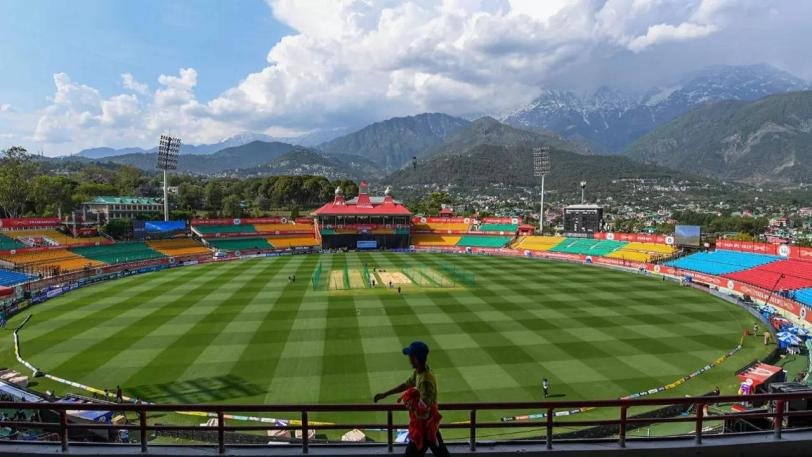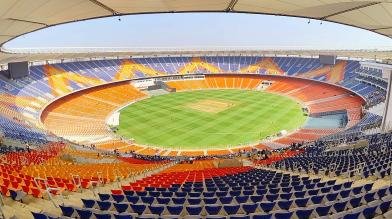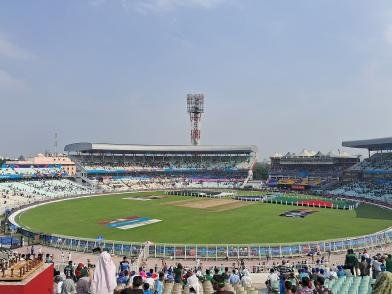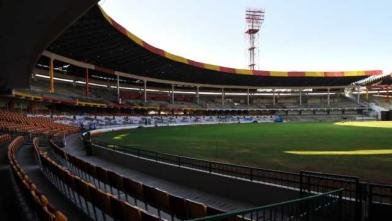Perched at an altitude of 1,457 meters with the snow-capped Dhauladhar mountains as its backdrop, the Himachal Pradesh Cricket Association Stadium in Dharamshala is a cricketing paradise that marries sport with nature’s grandeur. Known as one of the world’s most scenic cricket venues, this stadium offers an electrifying yet serene experience, drawing players, fans, and tourists alike. From its rich history to its modern facilities, the HPCA Stadium is a testament to Himachal Pradesh’s growing stature in global cricket, promising unforgettable moments for all who visit.
History of the Stadium
The HPCA Stadium was conceptualized in 2003 by the Himachal Pradesh Cricket Association (HPCA), driven by a vision to bring international cricket to the state and nurture local talent. Constructed at an estimated cost of 35 crore rupees, the stadium was built on a site leased from the state government, transforming a rugged hillside into a world-class venue. It was officially inaugurated in 2005 with a star-studded friendly match attended by the Dalai Lama, featuring cricketing icons like Sourav Ganguly, Steve Waugh, and Sachin Tendulkar, which put Dharamshala on the cricketing map. Over the years, the stadium has hosted pivotal moments, including its first international match—an ODI between India and England in 2013—and five high-profile games during the 2023 Cricket World Cup. Its journey from a regional dream to a global stage reflects the passion and perseverance of the HPCA, led by figures like Anurag Thakur, who played a key role in its development.
Location and Accessibility
Situated in the heart of Dharamshala, Himachal Pradesh, India, the HPCA Stadium is located at Cricket Stadium, Tehsil, Distt, Dharamshala, Himachal Pradesh 176215, offering stunning views of the Dhauladhar range. Its high-altitude setting at 1,457 meters makes it one of the highest cricket grounds globally. The nearest airport, Kangra Airport (Gaggal), is just 8 km away, a 20–30-minute taxi ride through winding, scenic roads (fares: ~INR 400–600). For rail travelers, Pathankot Railway Station, 85 km away, is the closest major hub, connected to Dharamshala by buses (INR 100–200) or taxis (INR 1,500–2,000). By road, Dharamshala is accessible from Chandigarh (250 km, ~5 hours) or New Delhi (475 km, ~9–10 hours) via NH44 and NH503, with regular HRTC buses or private cabs. Nearby attractions include McLeod Ganj (6 km), home to the Dalai Lama Temple, Bhagsunag Waterfall, and vibrant Tibetan markets, making the stadium a perfect blend of sport and tourism. Local auto-rickshaws and taxis ensure easy last-mile connectivity, though visitors are advised to plan for hilly traffic during match days.
Architecture and Design
The HPCA Stadium, with a seating capacity of 23,000, is a compact yet vibrant venue designed to immerse fans in the action. Its architecture, inspired by Tibetan aesthetics, features a grass-covered roof that blends seamlessly with the surrounding hills, vibrant color schemes, and open stands that maximize the Himalayan views. The field dimensions are relatively short, with straight boundaries at ~63 meters and square boundaries at ~68 meters, complemented by a fast outfield that rewards aggressive batting. The pitch, a unique blend of red and black soil, offers consistent bounce and pace, favoring batsmen in the early overs but providing spinners with turn as the game progresses. It was the first Indian stadium to use winter rye grass for its outfield, ensuring a lush, green playing surface even in temperatures below 10°C. The design prioritizes natural ventilation, with cool mountain breezes aiding fast bowlers, while modern floodlights enable seamless day-night matches. The intimate layout ensures every seat feels close to the action, with stands like the Pavilion Terrace and West Stand offering unobstructed views of both the game and the Dhauladhar peaks.
Famous Matches and Events
The HPCA Stadium has been a stage for cricketing brilliance across formats, hosting 17 international matches by 2025, including ODIs, T20Is, and a solitary Test. Its international debut came in 2013 with an India vs. England ODI, where Ian Bell’s century thrilled a packed crowd. The 2014 ODI against West Indies saw India post 330/6, powered by Virat Kohli’s 127, setting a venue record for the highest team total. The 2017 Test match between India and Australia was a classic, with Steve Smith’s resilient century and Ravindra Jadeja’s spin heroics stealing the show. During the 2023 Cricket World Cup, the stadium hosted five matches, including a high-octane India vs. New Zealand clash where Mohammad Shami’s 5/54 earned him Player of the Match honors. The venue has also been a home ground for Punjab Kings in the IPL, with memorable performances like David Miller’s explosive 80* in 2013. Beyond cricket, the stadium has hosted cultural events, including local festivals and music concerts, leveraging its modern infrastructure and scenic appeal. Notable records include the highest individual ODI score (Kohli’s 127) and the best bowling figures in an ODI (Shami’s 5/54).
Facilities
The HPCA Stadium is equipped with top-tier amenities to ensure a memorable experience for all. Spectators enjoy comfortable seating across stands like the North East Stand, Pavilion Terrace, and VIP Boxes, with clean restrooms and water stations. Food and beverage options include stalls serving local Tibetan momos, Himachali dham, and standard snacks like burgers and popcorn, though prices are slightly high (e.g., a coffee at INR 100). Visitors often recommend dining at nearby eateries in McLeod Ganj for budget-friendly options. Parking facilities are ample, accommodating up to 1,500 vehicles, with CCTV surveillance and security checks ensuring safety. For players, the stadium offers state-of-the-art dressing rooms, a gym, physiotherapy rooms, and indoor/outdoor practice pitches with nets. Media facilities are robust, featuring a press box with 50+ seats, TV and radio commentator booths, and a post-match conference hall equipped with high-speed Wi-Fi. The stadium’s eco-friendly initiatives, like rainwater harvesting and solar-powered lighting, add to its modern appeal, while high-security measures, including metal detectors, ensure a safe environment during high-profile events.
Unique Features
The HPCA Stadium’s defining feature is its unparalleled Himalayan backdrop, with the Dhauladhar range creating a postcard-perfect setting that elevates every match. Its high-altitude location influences gameplay, as thinner air allows the ball to travel 5–10% farther, benefiting big hitters and challenging bowlers to adapt. The open stands, devoid of high fences, offer unobstructed views, while the low-level seating brings fans closer to the action than in larger venues. The pitch’s unique soil composition and winter rye grass outfield ensure consistent playing conditions year-round, a rarity in India’s diverse climates. The stadium’s Tibetan-style architecture, with its grass roof and vibrant colors, reflects Dharamshala’s cultural heritage, earning praise from architects and fans alike. Fan zones with interactive games, giant LED screens for replays, and local music during breaks create a festive atmosphere. The cool mountain breeze, often aiding swing bowlers, adds a tactical layer to matches, making the HPCA a favorite among players like Jasprit Bumrah, who lauded its conditions in 2023.
Fan Experience
The HPCA Stadium offers a fan experience unlike any other, blending cricketing passion with the tranquility of the Himalayas. Visitors describe the atmosphere as electric yet intimate, with the 23,000-strong crowd creating a roar that echoes through the hills. A Tripadvisor review from March 2024, during the India vs. England Test, called the Pavilion Terrace “the best seat in cricket,” citing its proximity to the pitch and unobstructed mountain views. Fans love the cultural fusion, with Tibetan flags waving alongside Indian tricolors and local vendors selling momos and chai outside the gates. The smaller crowd size compared to venues like Eden Gardens ensures manageable queues and a personal feel, though some note the strict no-food policy in seating areas as a minor inconvenience. Day matches are a fan favorite, with sunlight illuminating the Dhauladhars, while night games under floodlights offer a magical ambiance. Social media posts on X highlight the stadium’s charm, with users sharing photos of snow-dusted peaks during matches, calling it a “bucket-list venue.” The nearby McLeod Ganj adds a post-match adventure, with cafes like Illiterati and trekking trails enhancing the overall trip.







